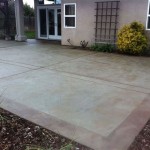How To Make a Patio on Uneven Ground
Creating a patio on uneven ground presents unique challenges, but with careful planning and execution, it's achievable. Uneven ground can disrupt the aesthetic appeal of a patio and pose structural issues if not addressed properly. This guide will provide a step-by-step approach to building a patio on uneven ground, ensuring both functionality and beauty.
Prepare the Site
The first step is to prepare the site thoroughly. This involves removing any existing vegetation, debris, and potentially loose soil. The goal is to create a level base for the patio. Here's a detailed breakdown:
-
Clear the area:
Remove all vegetation, including trees, shrubs, and grass. A combination of manual removal with a shovel and a weed trimmer can be effective. -
Remove debris:
Gather and dispose of any existing debris such as rocks, branches, and leftover building materials. -
Remove loose soil:
If the soil is loose or prone to settling, remove it and replace it with compacted gravel or other suitable fill material. The goal is to ensure a stable base for the patio.
After clearing the area, carefully assess the slope and unevenness of the existing ground. This will determine the extent of excavation and leveling required.
Leveling the Ground
Leveling the ground is crucial to ensure a structurally sound and aesthetically pleasing patio. Here's a detailed approach:
-
Establish a level reference point:
Use a laser level or a traditional level and string line to establish a reference point for the desired patio height. This will be your guide for determining the amount of excavation or fill needed in different areas. -
Excavate or fill:
In areas where the ground is higher than the reference point, excavate the soil to achieve the desired level. Conversely, in areas that are lower, add compacted gravel or fill material to bring it up to the reference point. This process may require multiple layers of fill, ensuring proper compaction after each layer. -
Check for drainage:
Ensure adequate drainage by creating a slight slope away from the house or any other structures to prevent water accumulation on the patio. This can be achieved by adding a gentle slope of 1/4 inch per foot.
Throughout the leveling process, use a level and a rake to check for consistency and to ensure smooth transitions between the different levels. The goal is to create a level base that provides a stable foundation for the patio.
Constructing the Patio Base
Once the ground is properly leveled, you can proceed with the construction of the patio base. This base will provide support and stability to the patio surface. The following steps are crucial:
-
Lay a gravel base:
Pour a layer of compacted gravel over the leveled ground. The thickness of the gravel base depends on the type of patio material used. A 4-inch layer is generally recommended for pavers, while a 2-inch layer may suffice for concrete. -
Install edging:
Install edging materials, such as concrete curbing or prefabricated edging, around the perimeter of the patio. This will help to define the shape of the patio and prevent the patio material from shifting or spreading. -
Lay the patio surface:
Depending on your chosen patio material, install the surface. For pavers, carefully lay the pavers in a level, consistent pattern, ensuring the joints between them are even. For concrete, pour and finish the concrete according to manufacturer instructions.
After laying the patio surface, allow sufficient time for the material to cure or set. This will ensure that the patio is structurally sound and ready for use.
Additional Considerations
Here are some additional considerations for making a patio on uneven ground:
-
Material Selection:
Consider the weight and load-bearing capacity of the chosen patio material. Heavier materials may require a thicker gravel base and stronger support structures. -
Drainage:
Ensure proper drainage to prevent water accumulation on the patio surface. This can be achieved by sloping the patio slightly away from the house or any other structures. Consider adding drainage channels or incorporating a permeable patio material. -
Professional Assistance:
For complex or extensive patio projects, consulting a professional contractor is recommended. They can provide expertise in site preparation, leveling, material selection, and proper installation.
By following these steps and considering these additional factors, you can successfully create a beautiful and functional patio on uneven ground. Remember to prioritize safety, adhere to local building codes, and seek professional advice when needed.

Retaining Walls Make Beautiful Raised Patios

How To Make The Most Of Your Sloped Yard Full Circle Land Design

Outdoor Flooring Over Grass Or Dirt Interlocking Tiles

Circle Patio On Uneven Ground

Outdoor Flooring Over Grass Or Dirt Interlocking Tiles

Diy Floating Deck Part 1 Planning And Layout Ugly Duckling House

Building A Surface Deck Over An Uneven Concrete Patio

How To Build A Shed Base On Uneven Ground Tiger Sheds

How To Cope With A Sloping Garden Alda Landscapes

How To Build A Raised Patio With Retaining Wall Blocks
Related Posts








